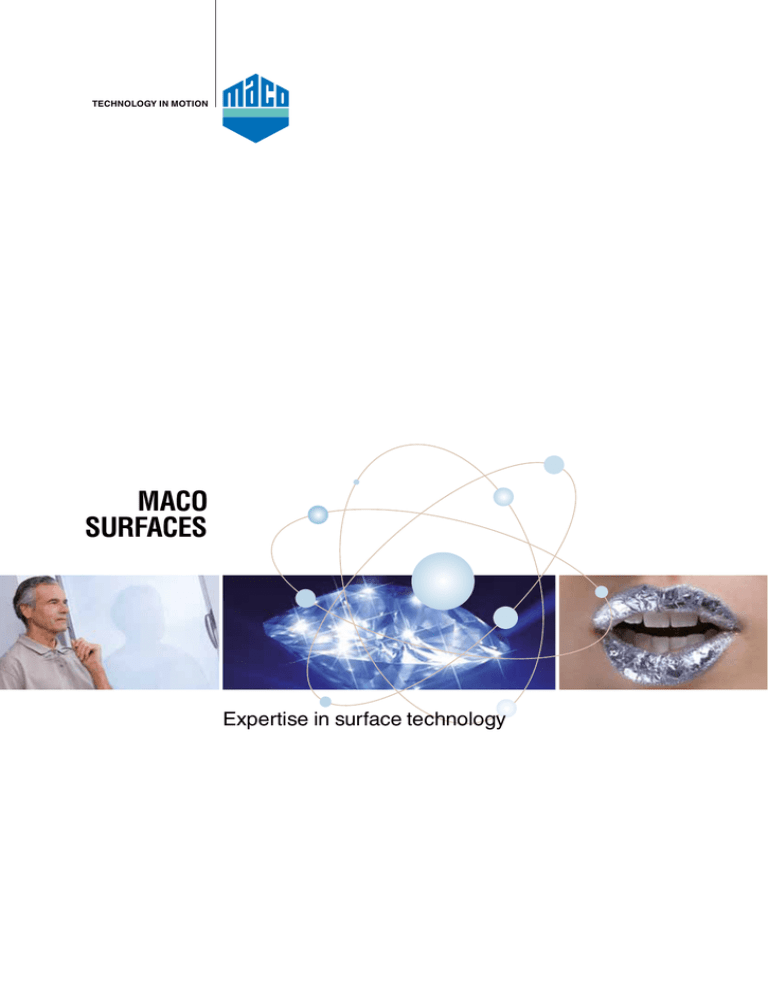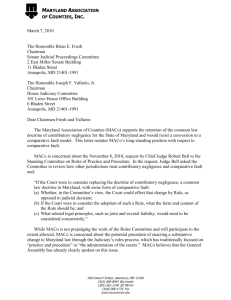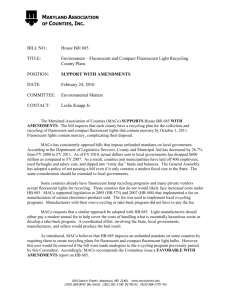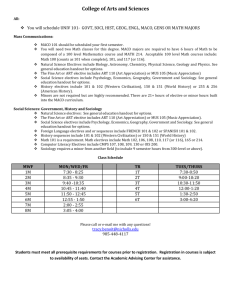
TECHNOLOGY IN MOTION
MACO
surfaces
Expertise in surface technology
MACO
surfaces
MACO uses seven different surface processing technologies in its in-house
production. This means MACO offers widest range of surfaces produced inhouse in the industry.
The right surface for every application
2
MACO
surfaces
Contents
Pages
Why is surface protection needed?
What is corrosion?
Materials processed by MACO
MACO surface technology
MACO silver-look
• MACO TRICOAT-PLUS
• Powder coating
MACO PREMIUM-PLUS
• Anodizing
• Wet varnishing
• Vacuum deposition
• Plastic coating
Tested according to standard EN 13126
Tested according to standard EN 1670
Surface quality testing
Preservation of surface protection for hardware components
4
5
6
7
8 – 9
10 – 11
12
13 – 14
15
16
17
18
19
20
21
22 – 23
3
MACO
surfaces
Why is surface protection needed?
• Does the base material protect against
environmental influences / corrosion?
• Aesthetics – decorative design options,
such as a variety of RAL colours
• Improvement of technical properties
(shearing, wearing properties, etc. )
4
MACO
surfaces
What is corrosion?
Corrosion means the attack and destruction of metallic materials by chemical or
electrochemical reactions with substances from the environment.
What are corrosive agents?
Corrosive agents are substances that surround the component and act on the material,
causing corrosion, e.g. air, the atmosphere
with or without industrial pollution, the marine
atmosphere, water, condensed water, soil or
chemicals.
Types of corrosion
Different types of corrosion may occur
depending on the nature of the material and
the respective corrosive agent. This includes
uniform surface corrosion, cavity and pitting
corrosion, contact and crevice corrosion,
selective corrosion as well as stress and
vibration-related corrosion.
Rusting of ferrous materials
= base metal corrosion (ferrous rust)
Due to the action of corrosive agents on ironbased materials, a loose, red-brown layer of
hydrous iron oxides is formed.
What is coating metal corrosion?
White rust forms initially on steel parts protected with zinc (corrosion coating metal). This
is because zinc is less noble than steel and
therefore acts as a sacrificial anode. That is,
as long as zinc is applied to the immediate vicinity of the corrosion point, the steel cannot
rust.
Ferrous rust
White rust
5
MACO
surfaces
Materials processed by MACO
MACO uses steel, ZAMAK, aluminium and PVC in the
production of hardware. The final surface finish ensures
corrosion protection and defines the appearance of the
hardware components in terms of colour and surface
texture.
Steel
Steel
Steel
Cuffs, bolts, RUSTICO shop fitting parts and
various small parts are made of high quality
cold-rolled band and sectional steels.
ZAMAK (zinc-base die-casting
alloy)
Strikers, bands and various small parts are
produced in a high quality die-cast zinc alloy
process.
Aluminium
Window and door handles are made from an
anodizable aluminium alloy.
PVC
Handles, caps, bushings and other small
parts are made from various synthetic
materials.
PVC
ZAMAC
Aluminium
6
MACO
surfaces
MACO surface technology
Broadest range of industries
• Seven different surface methods
• Application on hardware during the course of in-house production
Application methods
MACO product group
MACO silver-look
MULTI turn and T&T hardware,
PROTECT door locks,
RAIL-SYSTEMS slide hardware,
ESPAGS espagnolettes
PRO-DOOR front-door hinge plates
MACO TRICOAT-PLUS
MULTI turn and T&T hardware,
PROTECT door locks,
RAIL-SYSTEMS lift & slide hardware,
ESPAGS espagnolettes
Powder coating
RUSTICO shutter fittings in PREMIUM-PLUS,
MULTI pivot post and scissor stay hinges, EMOTION
window handles, PROTECT door locks and
PRO-DOOR door hinges
Anodizing
EMOTION window handles, RAIL-SYSTEMS
lift & slide hardware gear cuffs
Wet varnishing
Article from the EMOTION window handles range
Vacuum deposition
Caps (gold and chrome)
Plastic sheath
EMOTION window handle resist
7
MACO
surfaces
MACO silver-look
Back in the year 2000 MACO was the first
manufacturer of building hardware to
use chrome-VI-free silver passivation followed by silicate-based sealing in their
electrogalvanising process. This process
achieved excellent surface characteristic results and was the first alternative to
chromating with chromium VI.
Sealing
(with nano-structured silicon compounds)
Conversion layer
(thick-film passivation)
Zinc layer
Steel
Fittings manufactured from steel or die-cast zinc are
galvanised, passivated and sealed.
Thick-layer passivation and sealing serves to improve the
corrosion resistance and the appearance of zinc coatings
on metal.
8
8
MACO
surfaces
MACO silver-look
High corrosion resistance based an
environmentally friendly processes
Within the framework of state-of-the-art
systems and ongoing development particularly in electroplating (sealing with nano-structured silicon compounds), MACO has been
successful in fulfilling the requirements of
Class 5 in accordance with EN 1670:2008 for
turn and turn&tilt hardware.
The coating process in question is an exceptionally environmentally friendly process that
does not require the use of chromium VI.
Application areas
Electrogalvanised fittings have proved to be
ideal for normal stresses. However, despite
Class 5, these are only applicable to a limited extent for higher stresses such as damp
rooms, food processing companies,
coastal areas, certain types of timber, etc.
This is due to the chemical reaction of the zinc
coating to aggressive materials.
In application areas for which a high chemical
resistance we recommend the use of MACO
TRICOAT-PLUS hardware finish.
Fabricator benefits
• High-quality silver-look surface finish
• The highest corrosion resistance with
Class 5 in accordance with EN 1670:2008
• Ideally suited for normal environmental
influences/application areas
• Quality leadership on the strength of our
decade-long experience in the filed of
electrogalvanising
• Our window and door hardware is enhanced in ten electrogalvanising plants in our
modern in-house production facilities.
9
MACO
surfaces
MACO TRICOAT-PLUS
MACO TRICOAT-PLUS hardware has been specially developed for applications that
require enhanced corrosion protection.
The special feature of MACO TRICOAT-PLUS hardware is that an organic top coat
(‘MKS’ micro corrosion protection system) is applied on top of the electrogalvanised
surface of the silver-look hardware. This surface treatment enables MACO TRICOATPLUS hardware to achieve an exceptionally high level of chemical resistance and as a
result, is far superior to electrogalvanised hardware with regard to corrosion.
Ultimate corrosion resistance
thanks to highly-advanced surface
processing technology
The quality of the MACO TRICOAT-PLUS
hardware is well above the requirements of
Class 5 in accordance with EN 1670:2008.
MACO guarantees this with the 15 year
TRICOAT-­PLUS surface guarantee for the use
of MACO TRICOAT-PLUS fittings.
With its innovative TRICOAT-PLUS surface
coating process, MACO is the only hardware
manufacturer who can offer a full range of
highly corrosion-resistant products.
As with the MACO silver-look surface finish,
this is a highly-advanced technological process based on water-soluble varnishes.
10
10
What colours are available for
MACO TRICOAT-PLUS fittings?
MACO TRICOAT-PLUS is available exclusively in a light shade of grey (similar to RAL
9006 white aluminium). This colour provides
an aesthetic upgrade for all window and door
elements.
The following tests are under­­­taken
in order to ensure consistently
high quality
•
•
•
•
Salt spray test
Outdoor exposure test
Cross-cut test
Movement and durability testing
MACO
surfaces
MACO TRICOAT-PLUS
Hydro-baked enamel
E-coat
Conversion layer
Zinc layer
Steel
Fabricator benefits
•
•
•
•
•
Differentiating characteristics
Unrivalled aesthetics
Durability under extreme conditions
Ultimate corrosion resistance
No corrosion during construction phase compared to galvanic zinc plating
• Solutions for challenging application
areas
• Standard range in stock
• Processing and maintenance such as
MACO silver-look
• Proven quality through tests such as:
salt spray tests in accordance with EN
ISO 9227, weathering tests, etc.
• 15 year surface-finish guarantee for
use of MACO TRICOAT-PLUS hardware
• 10 year surface-finish guarantee for
use of MACO TRICOAT-PLUS with
Accoya® and oak.
• Available for MACO MULTI-MATIC
turn and T&T hardware, MACO
PROTECT door locks, MACO RAILSYSTEMS lift & slide hardware,
MACO ESPAGS espagnolettes
Possible applications
Examples
Regions with high salt content in the air and/or high air moisture
Buildings on the coast
Regions with high levels of pollution
Industrially congested areas, large cities
Timber with high acid content
Accoya® wood, oak wood
Buildings containing aggressive builder's dust (e.g. from gypsum plasterboard) or aggressive vapours (e.g. from drying screed)
New builds, refurbishments
Buildings where aggressive gases, acidic or alkaline vapours arise and
where people may be present for long periods without personal protective
equipment
Indoor swimming pools, livestock stables,
dairies, cheese dairies, butcher’s shops,
bakeries, breweries, beverage manufacturers
Damp rooms
Cellars, laundry rooms, bathrooms, saunas
Materials in which contact corrosion can arise
Aluminium windows
Sea transport
Window and door elements used at sea
Buildings with significant condensation formation
New builds, refurbishments, regions with
high temperature differences between night
and day, buildings at high altitudes
11
MACO
surfaces
Powder coating
MACO uses the powder coating method for MULTI pivot post and scissor stay hinges, RUSTICO shop fittings, PROTECT door locks, PRODOOR hinges and EMOTION handles. The advantage of powder coating
is the environmental friendliness of the fabrication process. In addition, the powder coating provides a high level of corrosion protection, it
is scratch resistant, and is water and stain resistant, thereby protecting
fittings against aggressive environmental influences.
MACO colours
Powder coated hardware is available in all the
RAL Classic colours, with the exception of
fluorescent colours (RAL 1026, RAL 2005,
RAL 2007, RAL 3024, RAL 3026, RAL 6038).
Powder coating
Conversion layer
Zinc layer
(omitted for ZAMAC)
Steel or ZAMAC
(The layer structure differs for RUSTICO shop fittings)
12
MACO
surfaces
MACO PREMIUM-PLUS
MACO RUSTICO shutter fittings are exposed to the effects of weathering.
Thanks to its incredibly high corrosion resistance, the new PREMIUM PLUS
surface puts everything else in the shade.
It is the result of targeted MACO research and development work in cooperation with external partners.
Unrivalled resistance
• 10-year surface guarantee
• Certification of over 2000 h corrosion resistance with test report from ift Rosenheim in
accordance with EN 1670:2008
• Tested quality through internal tests, such
as: salt spray tests in accordance with EN
ISO 9227, weathering tests, etc.
Application areas
MACO RUSTICO shutter fittings are
suitable for use in all locations, including coastal regions. The lifetime can
be increased further under corrosive
conditions by ensuring regular maintenance (cleaning and oiling).
13
MACO
surfaces
MACO PREMIUM-PLUS
MACO colours
MACO RUSTICO shutter fittings come in gray,
white and black. MACO offers its customers
all RAL Classic colours (except fluorescent
colours) at a surcharge.
14
Fabricator benefits
• Stand out from the competition
• 2000 h corrosion resistance in accordance
with EN 1670:2008 verified by ift Rosenheim
• 10-year surface guarantee
• Especially suitable for shops in coastal
areas
• Elegant appearance with fine structure
• High colour fastness
• Durable, scratch-resistant surface with
water and dirt repellent properties
• Environmentally friendly technology
MACO
surfaces
Anodizing
Suitable electrolytes with anodic process
with the help of DC and/or AC
• Hard
• Wear-resistant
• Weatherproof and
• decorative oxide coating applied to the
surface of the EMOTION handles and
RAIL SYSTEMS lift&slide gear cuffs
It is possible to produce aluminium surfaces
in a variety of colours
MACO colours
MACO anodized in the following colours:
Handles: c
hampagne, bronze, black brown, titan and silver
Lift&slide gear cuffs: silver, black brown and bronze
15
MACO
surfaces
Wet varnishing
Depending on requirements, wet spray
painting is undertaken according to the
following procedures for the EMOTION
handle range (shell handles, door plates,
rosettes, caps) and cover caps for MULTI
pivot posts.
1. Manual spray painting
2. Automatic surface spray painting
3. Automatic drum spray painting
Through the use of hydro paints (water-based
paints) a wide variety of colours are applied
in an extremely environmentally friendly process.
16
MACO
surfaces
Vacuum deposition
This method utilises a vacuum chamber and aluminium wire
which is evaporated at high temperature. This vapour is then applied to the workpieces by means of the vacuum.
The parts are then coated with a special
protective clear lacquer.
This lacquer can also be dyed. The protective
layer is hardened and made wear resistant by
means of high temperature drying. The
vacuum evaporation process is used primarily
for MACO PVC covers in gold and chrome.
Advantages
• This method enables special high-gloss
surfaces (metallic effect) to be created.
17
MACO
surfaces
Plastic sheath
Injection moulding technology is utilised to coat a die-cast zinc
core with a PVC layer for the MACO EMOTION HARMONY resist
window handle.
•
•
•
•
•
•
Extremely durable plastic surfaces
Perfect visual properties (colour, gloss)
Very high resistance to mechanical loads
Good chemical resistance
Good long term performance
No corrosion
HARMONY resist window handles
• The stable metal core is covered with a
3 mm PVC protective coating.
• The surface is extremely robust.
• Scratches and other signs of wear and tear
are hardly visible.
• EMOTION handles are coated in PVC in the
colours traffic white (RAL 9016) and grey
brown (RAL 8019).
18
Metal core
3 mm plastic
protective coating
MACO
surfaces
Tested according to standard EN 13126
EN 13126 is the standard for architectural
hardware and fittings for windows and doors.
This standard defines the requirements for test
methods for lasting functionability, strength,
security and operation. It is divided into 19 parts,
which cover all types of windows and doors.
What does this standard specify in
terms of corrosion resistance?
EN 1670 designates that fittings must correspond to the classes specified in the standard,
whereby at least Class 3 must be achieved.
Excluded from the assessment are
• Riveted areas
• Subsequently processed areas, for
example, cut fittings
• Parts where the surfaces have not been
processed, provided they are not in the
visible range of the fittings
• Welds and their immediate surroundings
19
MACO
surfaces
Tested according to standard EN 1670 EN 1670 is the standard for corrosion resistance of locks
and building hardware.
The corrosion resistance is divided into 5 classes
Class 1
24 hours
Low resistance for indoor use in dry environments
Class 2
48 hours
Moderate resistance for indoor areas where condensation /
moisture can occur
Class 3
96 hours
High resistance for outdoor areas where occasionally or frequently, moisture, rain or dew may occur
Class 4
240 hours
Outdoor areas with very harsh conditions
Class 5
480 hours
Outdoor areas with exceptionally harsh conditions where longterm protection of the product is required
The key points
The required corrosion tests must be carried
out on assembled parts as they correspond
to normal delivery conditions.
Only the corrosion of the base material is rated during the assessment, white rust is excluded from the review. Screws and fasteners
sold together with the hardware product must
also comply with the standard.
20
Test certificates and test reports are available on our website at www.maco.at
MACO
surfaces
Quality testing of the surfaces
MACO is certified to ISO 9001 (quality), ISO 14001
(Environment) and O lift & slide hardwareAS 18001
(occupational health and safety). All processes and
procedures
are defined.
The entire production process is secured by an
in-house production control system.
A continuous process control system is
achieved on the basis of the obtained values.
The individual processes are specified in
detail by means of working instructions.
This ensures constant surface quality and
corrosion resistance.
Monitoring is carried out by external certified
test institutes.
Test methods
• Salt spray tests in accordance
with EN ISO 9227
• Climate change test
• Xenon test to ensure UV
resistance
• Cross-cut test
• Layer thickness measurement
• Layer thickness determination
by means of micrograph
• Abrasion test
• Nail scratch test
• Colour measurement
• Detergent test
• Outdoor exposure test
21
MACO
surfaces
Preservation of surface protection for hardware components
A series of regulations must be observed to ensure the proper functions of the window
hardware. The following points should be taken into account so that end users can enjoy perfect operation and aesthetics of the windows and hardware.
Causes of corrosion on hardware components
Should signs of corrosion on hardware components develop after a short period of time in individual cases (despite surface protection), the following listed points are generally the cause of
corrosion:
a)The actual cause of corrosion is the atmospheric oxygen. In practice however, corrosion
only appears, when the relative humidity
reaches a critical value of approx. 60 to 70 %.
b)An additional cause of corrosion can be the
formation of condensation on the metal components; due to passing below the dew point
during severe fluctuation of temperatures.
c)Corrosion attacks have increased due to
gaseous air pollution (industrial atmosphere,
car exhaust emissions) e.g. sulphur dioxide
(SO₂) and nitrogen oxide gases (NO₂) and
resulting compounds in the presence of
humidity - sulphurous acid (H₂SO₃), sulphuric
acid (H₂SO₄), nitric acid (HNO₃).
This air pollution also has a corrosive effect in
a dry condition.
d)The location of the object affect must be
taken into account in connection with point
c) above, e.g. busy roads, industrial areas,
waste water treatment plants, sea air, air containing chlorine, intensive livestock breeding,
etc.
22
e)Also harmless materials e.g. paper/cardboard
as well as different types of timber used in the
fenestration industry partially contain aggressive components (aids, alkali, chlorides) that
can destroy the passivation upon contact and
thus cause corrosion.
f)Plaster, cement and other building materials
e.g. acetic acid cross-linked silicone as is
used frequently in the fenestration, industry,
are additional causes for corrosion.
g)A common and not sufficiently recognised
source of damage is cleaning by chemical attack (acetic cleaning, agents, acidic
cleaning agents with citric acid, cement
residue remover with phosphoric acid,
severe alkaline cleaning agents, etc.) or by
means of mechanical abrasion (abrasive
cleansers, steel wool), which destroys the
passivation and, as a result, accelerates
corrosion attack.
h)In coastal areas, sea water may settle on
the fittings in the form of spray and form
corrosive salt deposits.
MACO
surfaces
Preservation of surface protection for hardware components
Measures to preserve the surface-finish
• The
hardware and/or the rebate areas must
be ventilated sufficiently – in particular
during the building phase – so that they are
not exposed to direct wetness impact or to
condensation.
• Ensure that (permanently) humid air cannot
condense in the bearing and rebate area.
• The hardware must be kept free from
deposits and soiling from building materials
(building dust, plaster, cement etc.); this
means that the windows must be covered
appropriately.
• Aggressive vapours in conjunction with
small formations of condensation can lead
to fast corrosion on the hardware components.
• Timber frames and sashes with a high concentration of (tannic) acid must be treated
with suitable surface coatings to ensure that
these contents do not evaporate from the
timber.
• N
o acetic-acid or cross-linked acidic
sealing compounds or those with the above
mentioned contents may be used.
• The fittings may only be cleaned or
polished with mild, pH-neutral cleaning
agent in diluted form.
• When applying surface treatments, e.g.
when retrospectively painting or varnishing
windows and casement doors, the hardware components must not be treated and
must be protected against contamination
from such treatments.
• The hardware may not be damaged with
sharp edged tools.
23
MACO
surfaces
MAYER & CO BESCHLÄGE GMBH
ALPENSTRASSE 173
A-5020 SALZBURG
TEL +43 662 6196-0
FAX +43 662 6196-1449
maco@maco.eu
www.maco.eu
MACO DOOR & WINDOW
HARDWARE (U.K.) LTD
CASTLE ROAD EUROLINK
IND CENTRE SITTINGBOURNE
KENT. ME10 3LY
TEL +44 1795 433900
FAX +44 1795 433902
enquiry@macouk.net
www.macouk.net
Order No. 49510EN – Date: November 1999 – date changed: August 2015
All rights reserved and subject to change.
Graphic source: MACO, shutterstock.com, fotolia.com







